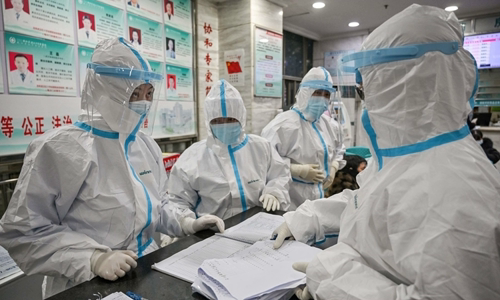China Many Wuhan doctors were initially wary of not knowing that nCoV was spread from person to person, but knowing that, they lacked protective gear.
China yesterday said 1,716 medical doctors were infected with corona virus, accounting for 3.8% of the total number of cases nationwide. Mainly among these are the Hubei Province health workers, with Wuhan alone accounting for 1,102 people. 6 infected health workers died.

Medical staff at a hospital in Wuhan on January 25 Photo: AFP
In May 2003, when the SARS epidemic (severe acute respiratory syndrome) was nearly extinguished, officials said 963 medical doctors were infected out of a total of 5,309 confirmed cases worldwide. The number of SARS infections in mainland China eventually increased to 5,237, of which 349 died.
In Hong Kong, 386 doctors were infected with SARS, 8 died. In total, the city recorded 1,755 infections and 299 deaths.
According to an essay by scientists from WHO and two other institutes in the Journal of Infectious Diseases and Public Health, MERS (Middle East Respiratory Syndrome) infected 415 medical doctors among 2,223 confirmed cases. received from September 2012 to June 2018.
Thai Hao Dong, an infectious disease specialist from Beijing Dia Dan Hospital, said the number of doctors with Covid-19 infection was much higher than the SARS and MERS epidemic because there were many patients who were initially hospitalized without symptoms. clear evidence. Many medical doctors became infected in January, when the government insisted there were very few cases of human-to-human transmission.
"The enemy is in the dark. The doctor may be caught off guard when the patient does not have any symptoms," Thai said.
Huang Zhaolin, deputy director of Wuhan Jin Yin Kim Hospital, whose article published in Lancet magazine about the clinical symptoms of Covid-19, started showing symptoms on January 17 and was confirmed received nCoV infection 5 days later.
Huang said he was infected from two asymptomatic patients when he met them on January 10. Initially, he thought he only had a cold and continued working at the hospital, even received experts from Beijing and held a press conference on January 19. On January 20, China admitted the virus spread from person to person.
The lack of protective clothing and masks also poses a high risk for health workers. Some medical doctors in Hubei have to buy their own money, rely on friends or rely on donations from other places in China and abroad. Young nurses are assigned to care for more serious cases because if unfortunately infected with the virus, they are more likely to recover than older colleagues.
More than 1,700 infected health workers are "a large number," said Professor Joseph Lau Tak-fai of the School of Public Health and Primary Care at the Chinese University of Hong Kong University.
He said that in the early stages of the epidemic, many patients showed no symptoms and doctors were not aware that they had an infectious disease. "In the second stage, although the doctors are aware of the virus being transmitted from person to person, they still have to go to the front line even though they do not have enough protective equipment."
"The cost is too high," Thai said.
The large number of doctors with viral infections also increases the risk of cross-infection in hospitals. "When doctors are infected, they can infect patients who are not infected with nCoV," she added.
WHO also confirmed that cross-infection in hospitals is a matter of concern. "It is important for health-care workers to protect themselves from the disease. Crossing in hospitals is a concern for all countries dealing with Covid-19," WHO wrote on Twitter.



 GeorgiaPapathanasiosSiemion
GeorgiaPapathanasiosSiemion







